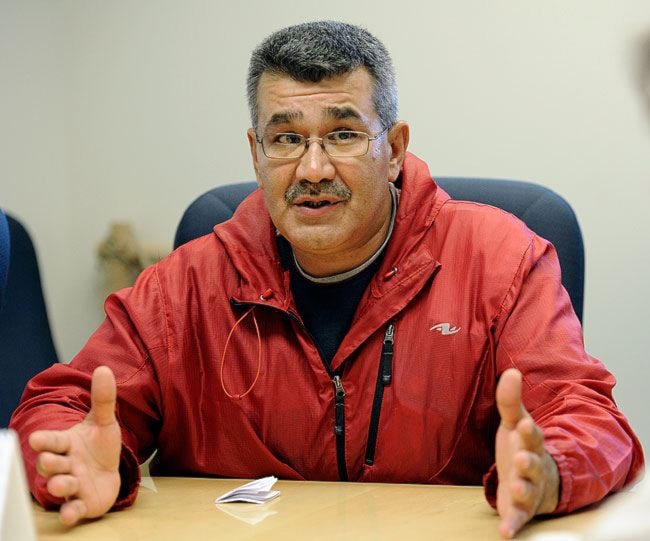Tr’ondek Hwech’in Chief Eddie Taylor says he almost fell out of his chair when he heard the Yukon government had put a hold on oil and gas exploration in the Whitehorse Trough.
“I’d like to fall out of my chair again,” Taylor told a news conference Friday, looking over at Yukon Premier Darrell Pasloski, referring to their dispute over the final Peel River watershed land use plan.
Taylor was among First Nation leaders who met with Pasloski and other Yukon politicians at what’s called the Yukon Forum.
The Peel and the Whitehorse Trough are as different as apples and oranges, said Pasloski.
“We had a position on the Peel and we didn’t have a position on oil and gas,” he said.
“When it comes to the oil and gas, this wasn’t something that we expected. It’s not something that we, as a government, had planned as part of our energy strategy going forward. I think most people know that we have been focusing in southeast Yukon and the Eagle Plains area, so I think that there is a difference there.”
In other words, the government agreed with the public when it came to oil and gas exploration in the Whitehorse Trough but it doesn’t agree with the public when it comes to protection of the Peel.
Pasloski’s government has rejected the recommended Peel land use plan, saying it protects too much of the watershed from industrial development. And he hopes the final round of public consultation will be completed this spring.
So, while the Peel process continues to drag on, work on the Dawson land use plan is now underway.
When Taylor was asked whether he trusts the government to respect public support of that plan, he said only that he’d like to.
“I’d sure like to trust the government,” the chief said. “But honestly, time will tell.”
The leaders did agree on one thing when it came to land use planning, entrenched in the Umbrella Final Agreement signed 19 years ago.
Ottawa has to pay for it.
Money is running out and only one land use plan in the least populated area of the territory, the North Yukon, has been signed.
The plan is to use the money that’s left and go together to the federal government to say more is needed, said Ruth Massie, Grand Chief of the Council of Yukon First Nations.
Land-based treatment for drug and alcohol abuse was also discussed at Friday’s meeting.
The Yukon government put $1 million in its recent budget for on-the-land treatment for people battling addictions.
That was less than the $2.8 million annually that was asked for by the Kwanlin Dun First Nation.
The Whitehorse-based First Nation has operated the Jackson Lake Healing Centre since the summer of 2010.
It’s one of the largest land-based centres in the Yukon and because of its location near Whitehorse, it receives clients from across the territory as well as from B.C. and Alberta.
But the budget’s $1 million over five years, divided between 14 First Nations, doesn’t go too far.
“We all know $200,000 is not sufficient to run a successful program,” said Chief Rick O’Brien, of the Kwanlin Dun First Nation.
“We have a lot of dreams for Jackson Lake and one day it will become a reality because it is an important issue for all First Nations, not only Kwanlin Dun, but for all First Nations. We have people that are incarcerated, who are screaming for a facility to be opened, such as Jackson Lake, and we will continue to lobby government to ensure that some sort of land base (centre), whether it be here or wherever, eventually opens up.”
The leaders agreed to establish a working group to figure out how to make the most of the money available.
The goal is to have one centre that the federal government may agree to fund.
O’Brien doesn’t consider the working group a snub to Jackson Lake.
“We’re open to building partnerships with other First Nations,” said Jeanie Dendys, Kwanlin Dun’s director of justice.
“We’ve promised our documents will be shared with all the other First Nations, including all our evaluation reports. Our thinking around First Nation, land-based healing has matured enough where we can now come out and be more forthcoming with the information and the details of the programming.”
Pasloski said the centre would more likely get federal funding if they created one accredited facility, but Dendys said there is no federal accreditation for land-based healing programs.
“There are no accredited land-based programs anywhere. So this is obviously an area that we’ll have to explore (with this working group) and determine whether that’s the best route to go with or not,” she said.
And even if everyone can agree on a central centre, the need for something “at home” will not change, said Chief Peter Johnston, of the Teslin Tlingit Council.
“I believe there is definitely a need for a central-based centre, which will probably be better-resourced in terms of more clinical and therapeutic support. But they’ve still got to come home and we have to learn how to deal with our addictions at home.”
Resource royalty sharing was also on the table at the meeting.
The leaders agreed to meet again, later this year, to discuss their progress.
Contact Roxanne Stasyszyn at roxannes@yukon-news.com
